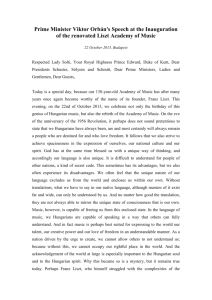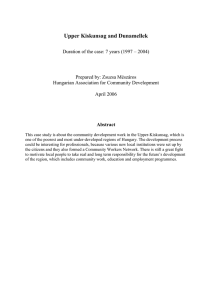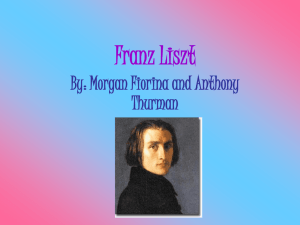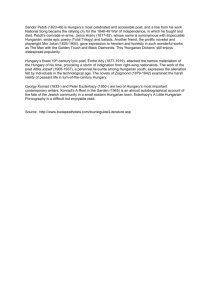Go to Péter Bozó statement from here
advertisement
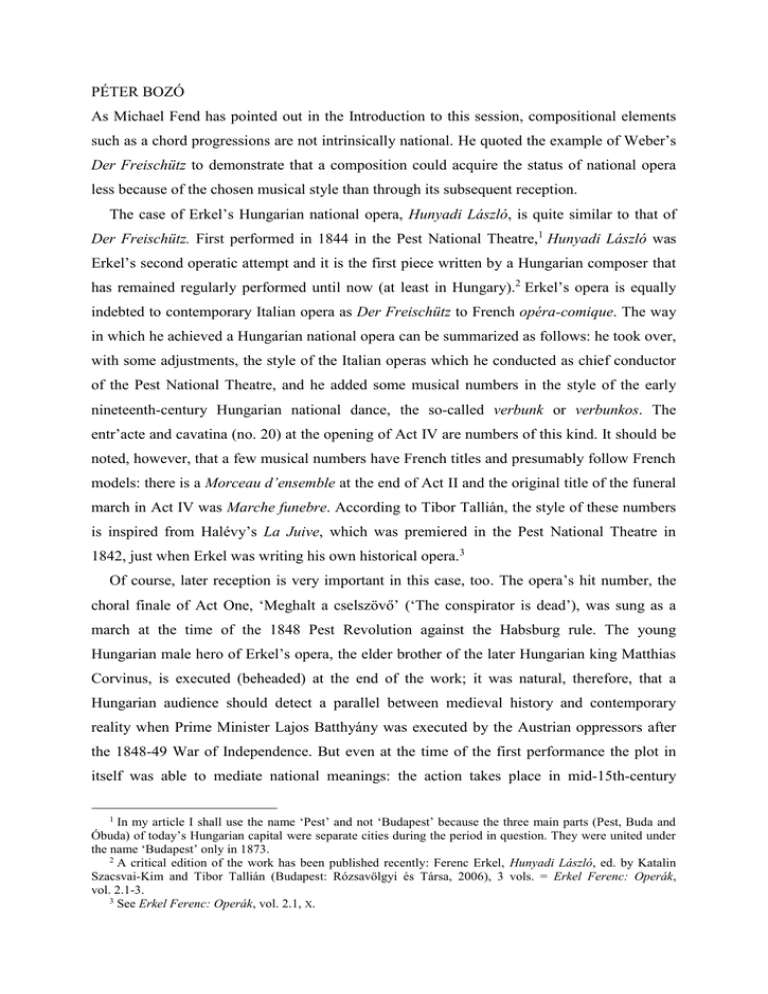
PÉTER BOZÓ As Michael Fend has pointed out in the Introduction to this session, compositional elements such as a chord progressions are not intrinsically national. He quoted the example of Weber’s Der Freischütz to demonstrate that a composition could acquire the status of national opera less because of the chosen musical style than through its subsequent reception. The case of Erkel’s Hungarian national opera, Hunyadi László, is quite similar to that of Der Freischütz. First performed in 1844 in the Pest National Theatre,1 Hunyadi László was Erkel’s second operatic attempt and it is the first piece written by a Hungarian composer that has remained regularly performed until now (at least in Hungary).2 Erkel’s opera is equally indebted to contemporary Italian opera as Der Freischütz to French opéra-comique. The way in which he achieved a Hungarian national opera can be summarized as follows: he took over, with some adjustments, the style of the Italian operas which he conducted as chief conductor of the Pest National Theatre, and he added some musical numbers in the style of the early nineteenth-century Hungarian national dance, the so-called verbunk or verbunkos. The entr’acte and cavatina (no. 20) at the opening of Act IV are numbers of this kind. It should be noted, however, that a few musical numbers have French titles and presumably follow French models: there is a Morceau d’ensemble at the end of Act II and the original title of the funeral march in Act IV was Marche funebre. According to Tibor Tallián, the style of these numbers is inspired from Halévy’s La Juive, which was premiered in the Pest National Theatre in 1842, just when Erkel was writing his own historical opera.3 Of course, later reception is very important in this case, too. The opera’s hit number, the choral finale of Act One, ‘Meghalt a cselszövő’ (‘The conspirator is dead’), was sung as a march at the time of the 1848 Pest Revolution against the Habsburg rule. The young Hungarian male hero of Erkel’s opera, the elder brother of the later Hungarian king Matthias Corvinus, is executed (beheaded) at the end of the work; it was natural, therefore, that a Hungarian audience should detect a parallel between medieval history and contemporary reality when Prime Minister Lajos Batthyány was executed by the Austrian oppressors after the 1848-49 War of Independence. But even at the time of the first performance the plot in itself was able to mediate national meanings: the action takes place in mid-15th-century 1 In my article I shall use the name ‘Pest’ and not ‘Budapest’ because the three main parts (Pest, Buda and Óbuda) of today’s Hungarian capital were separate cities during the period in question. They were united under the name ‘Budapest’ only in 1873. 2 A critical edition of the work has been published recently: Ferenc Erkel, Hunyadi László, ed. by Katalin Szacsvai-Kim and Tibor Tallián (Budapest: Rózsavölgyi és Társa, 2006), 3 vols. = Erkel Ferenc: Operák, vol. 2.1-3. 3 See Erkel Ferenc: Operák, vol. 2.1, X. Hungary, in the age of the Hunyadis, that is, in the ‘glorious past’ of the nation, which was particularly popular in Hungarian literature at the time of the national awakening4 and also became popular in Hungarian historical painting.5 As the example of Hunyadi László shows, if we are talking about musical nationalism, maybe we have to talk less about musical compositions than about the context surrounding them. If we want to study how music became part of nationalist projects, and how a musical piece acquired nationalist meaning, so-called extra-musical agents are often more telling than the composition itself. The room where a virtuoso’s concert took place, the clothes he was wearing during the performance, the text of the poems the composer set to music or the melodies he used in his fantasies; the illustration of a printed music score; or – as in the case of Hunyadi László – the plot of an opera libretto and the historical period in which it takes place – these may be more important agents in transmitting nationalist meanings than the music itself. In what follows I would like to show some examples of the ways nationalist meanings could be mediated by the activity of Franz Liszt. He can be seen as a particularly interesting figure from this point of view, because of his complicated national affiliations, and because both his Hungarian and his German reception were endowed with nationalistic character. Born into a German-speaking family in an area which in the early nineteenth century belonged to the Hungarian Kingdom, he became a French-speaking cosmopolitan artist during his early years in the French capital. But Liszt the cosmopolitan piano virtuoso truly mastered the art of how to captivate the benevolence of his audiences by appealing to their national feelings. That is why the American scholar Dana Gooley called him ‘a cosmopolitan nationalist’ in his fascinating book The Virtuoso Liszt.6 In 1840, during his Pest concert tour, Liszt gave a concert in the Pest Hungarian Theatre for the benefit of the same institution.7 It was the concert at the end of which he was awarded the notorious Hungarian sword of honour, a gift from the Hungarian nobility. The venue is very important in this case. Established in 1837, the Pest Hungarian Theatre was the first 4 To quote just a few examples: Sándor Kisfaludy, János Hunyadi (historical drama, 1816); Károly Kisfaludy, Simon Kemény (historical tragedy, 1820); József Gaál, The King in Ludas (historical comedy, 1837); Lőrinc Tóth, Two Lászlós (historical tragedy, the source of Erkel’s opera, 1839); Mihály Vörösmarty, Czillei and the Hunyadis (historical tragedy, 1844). 5 Two famous examples are Viktor Madarász, The Mourning of László Hunyadi (1859) and Gyula Benczúr, The Farewell of László Hunyadi (1866). 6 Dana Gooley, ‘The cosmopolitan as nationalist’, in The Virtuoso Liszt (Cambridge: Cambridge University Press, 2004), 117-155. 7 Zsuzsa Dömötör and Mária Kovács, ‘Liszt Ferenc magyarországi hangversenyei 1839–40’ [Liszt’s Concerts in Hungary, 1839-1940], in Liszt tanulmányok [Liszt Studies] (Budapest: Zeneműkiadó, 1980), 36-48. permanent institution in the Hungarian capital that provided theatrical performances in Hungarian, not only spoken plays but operas as well. Its foundation was an important step in the process of building a Hungarian nation. The term ‘nation’ in this context means what Friedrich Meinecke termed Kulturnation8 and what Anthony D. Smith calls the ‘non-Western model or ethnic conception of the nation’: 9 the Hungarian nation in the early nineteenth century was rather a community of birth and native culture than a political community and a territorial conception. The issue of language thus became a crucial question. At the time when the national awakening(s) of Hungary began, 10 the country was part of the multinational Habsburg Monarchy; what is more, it was in itself a multinational political entity where the rate of the Hungarian ethnic group was under 50%. 11 The most important centres of nineteenth-century Hungary were not unequivocally ‘Hungarian’ cities in the ethnic sense: in Pozsony or Pressburg (now Bratislava, the Slovak capital) and in Buda, the majority of the population was German-speaking; in Pest there were more German-speaking inhabitants than Hungarians, and people belonging to other ethnic groups of the Monarchy were also present, like Slovaks or Serbs. 12 The Pest German Municipal Theatre, founded in 1812, was more spacious than the Hungarian Theatre (3500 vs ca. 2000 seats).13 Now, by giving a concert in the Pest Hungarian Theatre for the benefit of this emphatically national institution, and no concert in the German Municipal Theatre, Liszt sent a message which could be easily decoded by the audience. Even more, he wore a Hungarian national costume during the concert and he played the Rákóczi March as an encore. Rákóczi was the leader of the early eighteenth-century war of independence against the Habsburg Emperor and as such he was regarded as a Hungarian national hero and a symbol of national independence. 8 Friedrich Meinecke, Weltbürgertum und Nationalstaat: Studien zur Genesis des deutschen Nationalstaates (Munich/Berlin: Oldenbourg, 21911 [11907]), 2-3. 9 Anthony D. Smith, National Identity (London: Penguin Books, 1991), 8-15. 10 Hungarian nationalism as a political movement arose at the end of the eighteenth century as a reaction of the Hungarian nobility against the language decree (1784) of Emperor Joseph II who wanted to make German the official administrative language in the whole empire. Nationalism in Hungary was not unequivocally a bourgeois movement, neither in the late eighteenth, nor during the nineteenth century: Hungarian aristocrats such as Count István Széchenyi or Baron Miklós Wesselényi played a leading role in the transformation of feudal Hungary into a modern civic state. 11 János Gyurgyák, Ezzé lett magyar hazátok. A magyar nemzeteszme és nacionalizmus története [‘Your Hungarian Homeland became this’: History of the Idea of Hungarian Nation and Hungarian Nationalism] (Budapest: Osiris, 2007), 21. 12 It should be noted, however, that many native German-speaking citizens opted for the Hungarian identity: for example, the man of letters Ferenc Toldy was born into a German-speaking family (his original name was Schedel) but he learned Hungarian and wrote his opera reviews in Hungarian. 13 For a documentary survey and repertory list of German theatrical life in early nineteenth-century Pest and Buda, see Deutsche Theater in Pest und Ofen 1770–1850, ed. by Hedvig Belitska-Scholz and Olga Somorjai, 2 vols. (Budapest: Argumentum, 1995). We have seen some of the devices which Liszt used to cater for his Hungarian audience. Now, for the sake of comparison, let us turn to the way in which he addressed his German audience in Germany at around the same time. The devices are quite similar. Liszt made his debut in Germany in 1840, at the time of the so-called Rhine crisis, when the French Prime Minister Adolphe Thiers declared that the left bank of the Rhine should belong to France. The German were naturally outraged and hundreds of Rhine-songs were composed and performed during the 1840s, as Cecilia Hopkins Porter has pointed out. 14 Probably the most famous of these songs was written by a certain Nikolaus Becker, with the title Der Deutsche Rhein (The German Rhine). On the other hand, French men of letters also wrote their own Rhin songs, for example Alfred de Musset his Rhin allemand as an answer to Becker. How could the French-speaking Liszt win over his German audience in such circumstances? One answer was to set to music Ernst Moritz Arndt’s nationalistic poem, Was ist des Deutschen Vaterland as a male choir.15 What is more, he conducted this poem in one of his concerts,16 he published it in Berlin and he dedicated the composition to the Prussian King Frederick William IV. 17 In this case the text set to music is particularly important. Written during the Napoleonic Wars, this is a poem about German unity in which the poet says: ‘Das ist das deutsche Vaterland / wo jeder Franzmann heißet Feind’ (This is the German Fatherland where all Frenchmen are enemies).18 It should be noted, however, that the Frenchspeaking Liszt changed these lines; he set to music the text as follows: ‘Das ist das deutsche Vaterland / wo jeder Frevler heißet Feind’ (This is the German Fatherland where all felons are enemies).19 Nevertheless, despite the change of text, most of his German listeners received the 14 Cecilia Hopkins Porter, The Rhenish Manifesto: ‘The Free German Rhine’ as an Expression of German National Consciousness in the Romantic Lied (PhD diss., University of Maryland, 1975). See also id., The Rhine as Musical Metaphor: Cultural Identity in German Romantic Music (Boston: Northeastern University Press, 1996). 15 He set to music Arndt’s text for the first time in the autumn of 1841. See his letter to the Princesse Belgiojoso in which he wrote that the sentiment and conclusion of the text was German Unity. Daniel Ollivier, Autour de Mme d’Agoult et de Liszt (Paris: Grasset, 1941), 181-182. 16 For a detailed description of the performance, see Gooley, The Virtuoso Liszt, 182-189. 17 Schlesinger’s edition appeared in 1842. According to the evidence of Liszt’s so-called Lichnowsky sketchbook (D–WRgs 60/N8, p. 7), at the beginning of the 1840s he also wanted to incorporate a male choir to his planned German Année de pèlerinage, together with his keyboard paraphrase Leier und Schwert and some of his first German songs (Die Loreley, Am Rhein im schönen Strome, Die Zelle in Nonnenwert). See Péter Bozó, ‘Liszt’s Plan for a German Année de pèlerinage’, Studia Musicologica 47/1 (2006), 19-38. 18 My italics. 19 My italics. piece with great enthusiasm,20 while the French press wrote that Liszt declared he was the enemy of his adoptive country.21 As Liszt’s debuts in Pest and Germany show, a cosmopolitan musician was able to act as a German nationalist and as a Hungarian nationalist at the same time. Cosmopolitanism and nationalism do not exclude each other. Péter Bozó Institute for Musicology of the Humgarian Academy of Sciences Táncsics M. u. 7 1014 Budapest Hungary pebozo@gmail.com 20 It should be noted, however, that the anonymous reviewer of the Leipzig Allgemeine musikalische Zeitung found the musical style of Liszt’s Arndt setting extreme and rather French than German. See ‘Recensionen’, AMZ, 45/40 (October 1843), 711-714. 21 See Léon Escudier, ‘Nouvelles’, La France musicale 5/26 (26 June 1842), 233; id., ‘MM. J[ules] J[anin] et Franz Liszt’, La France musicale 5/28 (10 July 1842), 246. Cf. the famous caricature by Alcide Joseph Lorentz portraying Liszt on a war horse, with the Hungarian sword of honour on his right; Miroir drolatique (8 juillet 1842). <http://gallica.bnf.fr/ark:/12148/btv1b7721462x /f48.item> (accessed: 1 October 2007).

